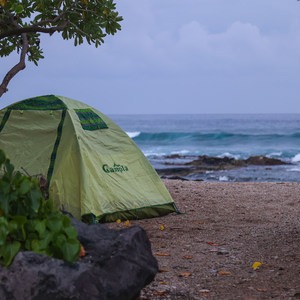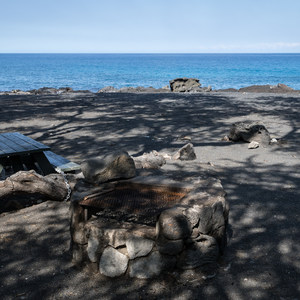You are here
Kuamo'o Battlefield and Lekeleke Burial Grounds
The kapu system of laws and taboos that helped to structure the daily lives of Hawaiians had ancient origins and diverse applications. There were practical laws such as those that protected fisheries from overfishing and allowed ground to lay fallow and regenerate over winter, but there were plenty of other laws and prohibitions that shaped social behavior: It was kapu, for instance, to step on the shadow of an ali'i, or chief, and it was kapu for men and women to eat together. Frequently the punishment for violating a kapu was death, though the transgressor was sometimes given the opportunity to receive pardon and sanctuary at Pu'uhonua o Hōnaunau. The kapu system helped to make the ancient culture what it was: strong, tough, resourceful, but also strict, combative, and sometimes brutal.
The kapu system had its supporters, but as time wore on and the Hawaiians had more interactions with Europeans, the number of Hawaiians who resented the kapu system grew and grew. King Kamehameha I used the kapu system to rule, but when he died in 1819, his wife, Queen Kaʻahumanu, and his son, Liholiho, had other plans. In November 1819, Liholiho, who had become King Kamehameha II, put an end to the kapu system forever by destroying some temples and ceremoniously eating in public with women. He was challenged by Kekuaokalani, a nephew of Kamehameha I, who gathered an army to rise against his cousin, Kamehameha II. The armies clashed here at Kuamo'o Battlefield in the first months of 1820, Kekuaokalani lost decisively, and both he and his wife were killed on the spot along with more than 300 others. The ancient Hawaiian kapu system and religious structure came to an end even before the Christian missionaries arrived in March, 1820.
End of the World
While many visit this site to appreciate this watershed moment in Hawaiian history, today this site is also popular for an entirely different purpose. Take the gravel road through the battlefield and burial grounds and look for a trail that leaves from the right toward the 30- to 35-foot cliffs popularly known as the End of the World. When the conditions are right, this area is a favorite for thrill seekers who can overlook the risks for some airtime and a plunge into the Pacific.
And the risks are real: Rocks can shift and move given the powerful surf, potentially ruining the landing; the only way back up is to climb the cliff; the ocean surge can roll or slam you against the jagged rock as you approach it. No lifeguards, distant emergency resources...there are plenty of factors to consider.
But if the leap still sounds appealing, it isn't one you're likely to forget any time soon. The main jumping area is near the cave, but people jump from different areas and different heights at End of the World. You may not find anyone else there mid-week or when the conditions are a little choppy, but expect company when conditions are calm on the weekends. With no trash cans or restrooms, crowds can really make an outsized impact; be sure to pack out what you pack in and leave no trace.











Comments
Sign In and share them.